![]()
![]()
![]()
Use LEFT and RIGHT arrow keys to navigate between flashcards;
Use UP and DOWN arrow keys to flip the card;
H to show hint;
A reads text to speech;
53 Cards in this Set
- Front
- Back
|
Puberty
|
›The period of time during which physical
development changes from that of a child to full adult reproductive capacity (secondary sexual development) ›Puberty is a biological event ›Puberty is the major hormonal transition in life (others are pregnancy, menopause, andropause) |
|
|
"arche
|
- the begining
|
|
|
Adolescence
|
›Encompasses both the physical and psychosocial
aspects of growth and development ›Spans a greater time period than puberty – adolescence is the second decade of life (10-19 years) ›Youth is 12-24 years and includes young adulthood ›Puberty almost certainly adds to the complexities of adolescence ›Puberty, unlike adolescence, has a clear endpoint |
|
|
Human puberty differs from other animals
|
›Growth spurt
›Adrenarche (except a few primates) ›The length of time between the completion of puberty and optimal reproductive age (the human head is soo big compartively, thus need the extra time to be-able to birth a child) ›Delay in brain maturation compared to other physical growth |
|
|
Important events of puberty
|
1. Height growth
2. Weight growth – lean mass (muscle & bone) and fat mass 3. Body composition change 4. Bone mass accretion 5. Gonadal steroid production (testosterone and oestradiol) & attainment of reproductive capacity |
|
|
Pubertal Growth Rates
|
› In about 2.5 years, boys gain 30cm and 30kg and girls gain 20 cm and 20kg, second only to ›Growth in utero, an average of 70cm/year
|
|
|
End points of Puberty
|
1. Epiphyseal (bone growth plate) fusion
2. Near adult bone mass 3. Full secondary sexual development (as described by Tanner staging) 4. Menstruation with ovulation/mature spermatogenesis |
|
|
Main Pubertal Hormones
|
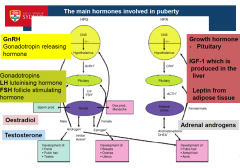
|
|
|
Puberty Part of a continuum
|
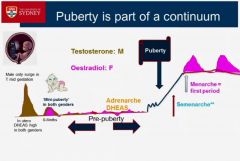
we are born to go through puberty immediately but the brakes are always put on
- girl babies have breast development - boys get testies enlarged then receed |
|
|
Initiation of Puberty
|
› Gonadotrophin hormone releasing hormone (GnRH) neurons in the hypothalamus have widespread
projections › Kisspeptin activation of GPR 54(gprotein receptor) is important for the activation of these neurons at puberty › Their activation results in an increase in frequency and amplitude of GnRH secretion - initially at night which is detected clinically by nocturnal LH surges in the blood |
|
|
Kisspeptin
|
› Kisspeptin neurones in the arcuate
nucleus also produce - neurokinin B (TAC 3) required for the onset of puberty - dynorphin which inhibits GnRH production › Glial (non-neuronal) factors may also facilitate puberty onset |
|
|
Timing of puberty
|
›Normal range for onset 8 - 13 F and 9-14 M
›Normal range for duration 2 - 5 years ›Because of this variability chronological age does not define developmental stage |
|
|
Bone Age
|
›Descriptor of developmental stage
›Uses X Ray of hand/wrist ›A better descriptor of developmental stage than chronological age. ›Two grading systems where the individual XRay is compared with radiographic pictures -Greulich Pile - Tanner Whitehouse - EXAMPLE: average bone age for a female at menarche is 13.5 yrs |
|
|
Height growth in females
|
›Mean peak growth velocity 8-9 cm/year in
females ›Growth spurt in the female is an early puberty event and is initiated and maintained by - Ovarian oestradiol (low levels) plus - Pituitary growth hormone (increase in frequency and size of nocturnal peaks) / IGF1 which act synergistically › 20 cm average gain ›Halted by epiphyseal closure - oestradiol (high levels) - THEREFORE THERE IS A PROBLEM WITH EARLY OCP USE |
|
|
Height growth in males
|
›Mean peak growth velocity 9-11.5 cm/year in males
›Growth spurt in the male is a late puberty event and is initiated and maintained by - Testicular testosterone (higher levels) plus - Pituitary growth hormone (increase in frequency and size of nocturnal peaks) / IGF1 which act synergistically › 30 cm average gain ›Halted by epiphyseal closure - High level oestradiol (aromatisation from testosterone) |
|
|
Growth curves for males and females
|
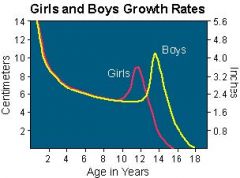
boys on average 10-12cm taller
|
|
|
Weight Gain
|
Males
› 30kg average gain › Increase in lean body mass & › Decrease in fat mass under the influence of testosterone › Weight gain is a late pubertal event – height first and then bulking up Females › 20 kg average gain (50% in peri-menarchal year) › Increase in lean body mass › Relatively greater increase in fat mass in oestrogen dependent areas (breast, thighs, buttocks) › Initiated and maintained by GH/IGF1 and oestradiol |
|
|
Increase in Bone Mass
|
›Accumulated during growth spurt and beyond
›Peak bone mass nearly achieved by end of second decade ›Pubertal growth abnormalities may inhibit accumulation of bone mass and result in risk of future osteoporosis/fracture › The increase in bone mass is initiated and maintained by GH/IGF-1, oestradiol or testosterone, adequate dietary calcium and Vitamin D, and physical activity |
|
|
Tanners Staging: Breast
|
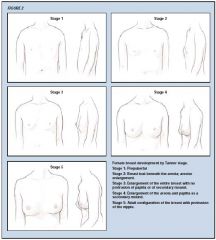
|
|
|
Tanners Female Hair Development
|
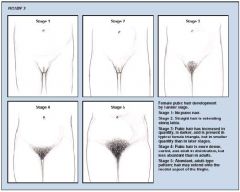
|
|
|
Tanners Male Hair Development
|
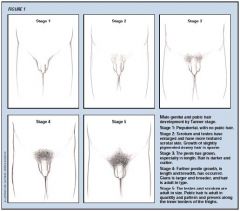
|
|
|
Tanner Genital Stages Male
|
› 1 Pre-pubertal – testes < 3ml
› 2 Testicular enlargement - 4-8ml; penis ~ 6cm › 3 Testicular enlargement and penile lengthening 10-12ml › 4 Testicular enlargement 15ml +; penis lengthens and widens › 5 Adult – testicles 20-25ml; penis ~ 12.5cm |
|
|
Secondary sexual characteristics - M
|
› Voice breaks (G3/4)
- Vocal cords lengthen - Larynx & cricothyroid cartilage increase in size - Laryngeal muscles enlarge › Body and facial hair (G4/5) - Later development (as is muscle bulk) - Amount of hair genetically determined by sensitivity of androgen receptor › Acne (G4/5) - Result of increasing testosterone - Usually resolves despite continuing adult testosterone levels |
|
|
Changes leading to capacity for
menstruation and ovulation |
›Cervix and uterine muscle and uterine lining
(endometrium) growth under the influence of oestradiol › Fluctuation in oestradiol levels causes a withdrawal bleed (shedding of endometrium) as menarche – early cycles are usually anovulatory ›High oestradiol levels produce a positive feedback on LH with pre-ovulatory surge in the more mature menstrual cycle and progesterone production from the ovary in the second half of the cycle progesterone is the painful part of mensturation and thus first few arent painful - dont reach menarch until have enough bosy weight |
|
|
Menarche - the first menstruation
|
›A certain percentage of body fat is required
›Generally anovulatory (no egg produced) ›Mean age 12.3 years in Australia ›95% height growth completed › 6-12 months to establish the cycle ›Secular trends - (Age of menarche has been falling over the past century in Westernised countries but now stabilising) |
|
|
Hormonal Changes of Male Puberty
|
› Slow increase in testosterone levels in childhood- most
assays not sensitive enough to detect (same for oestradiol in females) › Increased frequency and size of LH pulses from pituitary (via GnRH) - Leydig cells stimulated to produce testosterone › Increased frequency and size of FSH pulses from pituitary (via GnRH) - growth of seminiferous tubules and Sertoli cells – increase in testicular size |
|
|
LL
|
LH
Leydig cells |
|
|
SSS
|
FSH
Sertoli cells Seminiferous tubules Sperm |
|
|
Changes leading to capacity for spermatogenesis & ejaculation
|
›Growth of seminiferous tubules
›Mitoses and maturation of the Sertoli cells LEADS TO testicular enlargement ›Seminal vesicle and prostate enlargement › Increase in testicular blood flow ›Penile growth ›Sperm production from 13.5 years ›Secular trend for earlier onset of testicle enlargement over last 30 years |
|
|
Other important hormones of puberty
|
› Increase in growth hormone production by anterior pituitary which causes an increase in Insulin-like Growth Factor 1(IGF1) from liver and in tissues
› Transient insulin resistance (secondary to GH increase) › Increase in leptin production (early) - which decreases later in males only – permissive role, measure of energy stores › Increase in adrenal androgen production which is not dependent on GnRH |
|
|
Adrenarche
|
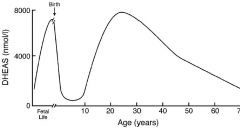
Independent of gonadal
maturation and clinically detected as pubic hair (pubarche) ; also acne, seborrhoea, body odour Commences before gonadal maturation; adrenal androgens start to rise soon in early childhood (DHEA, DHEAS & androstenedione) Trigger is unknown - No good evidence for anything other than pituitary ACTH (adrenocorticotrophic hormone) and no clear reason as to why adrenarche might be an advantage |
|
|
Variation in timing of the onset of puberty
|
› Genetic – normal distribution curve – (describes
40-70% of variance) › Birth - small for dates, prematurity, post-term (earlier) › Obesity earlier in girls; ?later in boys ›Malnutrition or excessive exercise: intentional/unintentional later/delayed › Chronic illness later/delayed › Visually impaired earlier (role of melatonin and sleep training?) › Overseas adoptees earlier |
|
|
Potential environmental effects on puberty timing
|
›Chemical pollutants (endocrine disruptors)
- Mostly as a result of localised pollution - Delay or advancement of puberty - Increasing prevalence of hypospadias & lower sperm counts ›Westernised environments earlier - Changes in nutrition and physical activity with changes in body composition ›Reduced childhood infections earlier ›Absent biological fathers earlier in girls - ? phaeromones |
|
|
Delayed/absent/halted puberty
|
› Maturational delay (delayed puberty) will ultimately
spontaneously correct › Defined as no signs of puberty by 13 (F) and 14 (M) › It may be difficult to differentiate extreme delay from absent puberty › Both medical and social pressures dictate management which is the use of low dose oestradiol (F) or low dose testosterone (M) › The longer the delay the more likely it is to be absent ›An interruption in puberty development or a reduction in the pace of change may be pathological |
|
|
Puberty and long term health
|
›Early menarche: increased incidence of
- Breast cancer - Eating disorders - Depression ›Late onset of puberty: increased incidence of -Osteopaenia and fracture risk in later life - Anxiety disorders |
|
|
Male puberty - gynaecomastia
|
›Occurs in over 80% of normal males in
Tanner stage Genital 3/4 ›Varying size; unilateral or bilateral ›Generally resolves with no treatment, but may require surgical removal** › If prolonged and marked consider secondary cause - Klinefelter syndrome (47XXY) - Drugs; marijhuana, cimetidine, aldactone - Thyrotoxicosis - Feminising tumours – extremely rare |
|
|
Female puberty - unequal breast development
|
›Early puberty - breast bud maybe unilateral
›By the end of puberty minor breast inequality very common ›Small % of women have noticeable difference in breast size - not a hormone abnormality - due to local growth factors or - rarely previous trauma to breast bud › Therapy is non medical |
|
|
Female puberty - body hair
|
› Increase in limb and eyebrow hair occurs in puberty as
well as the development of secondary sexual hair › Hirsutism = increase in terminal hair - increased androgen sensitivity (familial) - polycystic ovaries (especially if menstrual disturbance & acne) - disorders of the adrenal gland - late onset congenital adrenal hyperplasia - Cushing syndrome |
|
|
Premature adrenarche
|
› More frequent in low birth weight children
› Present with - Secondary sexual hair (pubic, axillary) - Acne, seborrhoea - Increased body odour › May have - Slight advancement of bone age - Mild increase in plasma adrenal androgens › Exclude - Congenital adrenal hyperplasia, androgen producing tumours › Treatment - Generally expectant but associated with later polycystic ovaries in females |
|
|
Premature thelarche - female
|
›Present with breast development, but no other
pubertal signs › To make diagnosis must have pre-pubertal oestradiol levels ›Exclude - exogenous oestrogen source - true precocious puberty with advanced bone age & elevated oestradiol › Treatment - expectant |
|
|
Pathological Puberty Problems
|
- Primary gonadal dysfunction
- Pituitary dysfunction (secondary gonadal dysfunction) - Hypothalamic dysfunction (tertiary gonadal dysfunction) - Adrenal malfunction with the excessive production of testosterone/oestradiol or related hormones as the adrenal has similar steroid hormone production pathways - Androgens or oestrogens (similar to testosterone or oestradiol) from other sources |
|
|
Absent puberty in the female 1o
|
›Primary gonadal failure: high FSH & LH, low
oestradiol - Turner syndrome 45XO (and other karyotype variants) - Premature menopause - auto immune - Chemotherapy - Galactosaemia inadequately treated (rare metabolic disorder) - Torsion (bilateral) - Surgical removal - Irradiation as part of cancer therapy Hormone replacement therapy is required to initiate puberty – oral preparations mainly |
|
|
Turner syndrome
can be held negligent if you dont do a genetic test in a female with 1. ______________ |
Short stature
Low set ears and hairline Ptosis Neck webbing Shield chest Increased carrying angle Partial or absent secondary sexual development Primary amenorrhoea Congenital cardiac valve lesions Absent or horseshoe kidney Conduction deafness Scoliosis Learning difficulties |
|
|
Absent puberty in the male 1o
|
›Primary gonadal failure: high FSH & LH, low
testosterone - Klinefelter syndrome 47XXY - Chemotherapy - Trauma & torsion (bilateral) - Cryptorchidism (undescended testicles) - Radiation damage (cancer therapy) - Infection (mumps) |
|
|
Klinefelter Syndrome
|
Small testicles
Tall stature Eunuchoid (long limbed) - not enough E to fuse the bones Gynaecomastia Failure to enter puberty Scoliosis Learning difficulties In less severe forms infertility may be the only symptom (azospermia) have normal pubic hair because no problem with adrenal androgen production |
|
|
Absent Puberty Male and Female 2o
|
›Secondary gonadal failure – pituitary
disorders; low FSH, LH and low oestradiol (F) or testosterone (M) - Genetic pituitary deficiency - Tumour replacing normal pituitary tissue - Trauma, especially to pituitary stalk - Radiotherapy damage (cancer therapy) - Surgery (often to remove tumour) Usually associated with other hormone deficiencies Hormone replacement is required to initiate and maintain pubertal change. Use oestradiol and testosterone (LH and FSH can only be given by injection) |
|
|
Absent Puberty Male and Female 3o
|
› Tertiary gonadal failure – hypothalamic
disorders; low FSH, LH and low oestradiol (F) or testosterone (M); indistinguishable on blood tests from secondary gonadal failure (GnRH not detectable in periphery) - As a result of chronic disease and debility (functional – GnRH suppression ) - Isolated GnRH deficiency (Kallman syndrome anosmia) - Head trauma - Iron deposition (iron overload states such as thalassemia major if inadequate chelation with hypertransfusion) - Tumours - Irradiation therapy for tumours Usually associated with other hormone deficiencies Hormone replacement to initiate and maintain pubertal change, same as 1o and 2o gonadal failure; GnRH is injection only |
|
|
Damage to the hypothalamus
|
› Craniopharyngioma
› Glioma,meningioma › Teratoma,germ cell tumour › Tumour metastases › Aneurysm (artery) › Surgery,radiotherapy › Syndromes (Prader Willi) and result in › Pituitary hormone deficiency & in some but not all situations hyperphagia, reduced physical activity, sleep disturbances, rage and emotion control disorders |
|
|
Primary Amenorrhoea – no menarche
|
1. Hypothalamic - pituitary disorder/disease
2. Ovarian disease/disorder 3. Mullerian agenesis * with absent - uterus - fallopian tubes - upper 2/3 vagina 4. Imperforate hymen* thye get normal BREAST DEVELOPMENT (DDx); get a complete block thus build up of blood (present to ED with abdominal pain) 5. Androgen insensitivity syndrome * - XY karyotype - feminised with endogenous oestradiol from testosterone |
|
|
Androgen insensitivity syndrome
|
• 46XY
• High testosterone (which is aromatised to oestradiol) •Non-functioning androgen receptor •tall stature •female phenotype •little body hair • inguinal gonads (testes) •lower 1/3 vagina only tall, strong women that can compete with women |
|
|
Precocious puberty
|
Precocious puberty is very different to the secular change in menarche. It is the abnormally early activation of the normal puberty hormone sequence
earliest mother 6yrs old True, central, GnRH dependent; increased LH, FSH and oestradiol or testosterone following a normal puberty pattern but appearing too early |
|
|
Pseudo-precocious puberty Isosexual
|
GnRH independent Isosexual (same sex
puberty change); low FSH and LH with high oestradiol (F) or testosterone (M) - McCune - Albright Syndrome in females (ovarian autonomy) via intrinsic hyper-function of FSH receptor - Testotoxicosis in males (often familial) - via intrinsic hyper-function of LH receptor - Exogenous oestrogen/androgens** - Ovarian/testicular tumours** - Adrenal tumours** |
|
|
Pseudo-precocious puberty Contrasexual
|
GnRH independent contrasexual (opposite
sex puberty change) with low FSH and LH and high oestradiol (M) or testosterone (F) Females – virilisation; acne, deep voice, loss of body fat, clitoromegaly - Congenital adrenal hyperplasia - enzyme defect with over production of testosterone and other androgens - Adrenal or ovarian tumour producing predominantly testosterone and other androgens - Exogenous androgen exposure Males – feminisation; breast development, loss of muscle - Adrenal or ovarian tumour producing predominantly oestradiol and other oestrogens - Exogenous oestrogen exposure |

